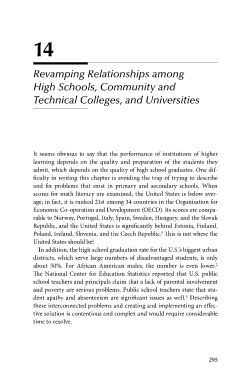Page 325 - Crisis in Higher Education
P. 325
14
Revamping Relationships among
High Schools, Community and
Technical Colleges, and Universities
It seems obvious to say that the performance of institutions of higher
learning depends on the quality and preparation of the students they
admit, which depends on the quality of high school graduates. One dif-
ficulty in writing this chapter is avoiding the trap of trying to describe
and fix problems that exist in primary and secondary schools. When
scores for math literacy are examined, the United States is below aver-
age; in fact, it is ranked 21st among 34 countries in the Organisation for
Economic Co-operation and Development (OECD). Its scores are compa-
rable to Norway, Portugal, Italy, Spain, Sweden, Hungary, and the Slovak
Republic, and the United States is significantly behind Estonia, Finland,
Poland, Ireland, Slovenia, and the Czech Republic. This is not where the
1
United States should be!
In addition, the high school graduation rate for the U.S.’s biggest urban
districts, which serve large numbers of disadvantaged students, is only
about 50%. For African American males, the number is even lower.
2
The National Center for Education Statistics reported that U.S. public
school teachers and principals claim that a lack of parental involvement
and poverty are serious problems. Public school teachers state that stu-
dent apathy and absenteeism are significant issues as well. Describing
3
these interconnected problems and creating and implementing an effec-
tive solution is contentious and complex and would require considerable
time to resolve.
295

